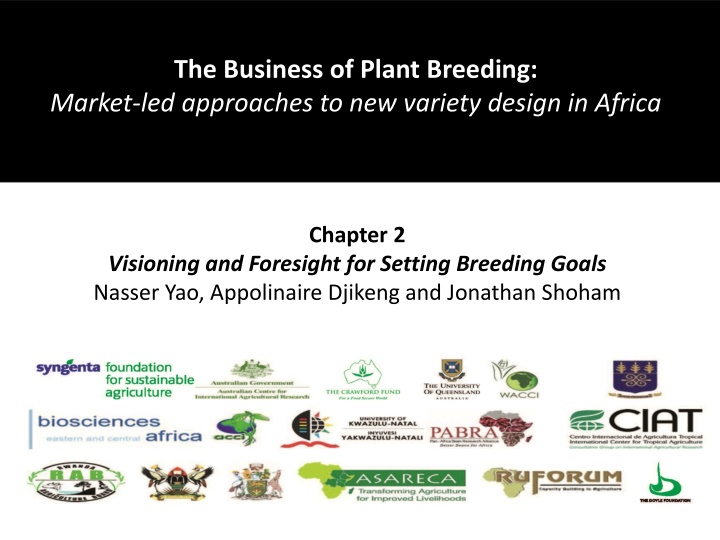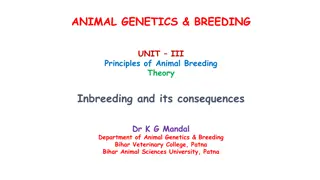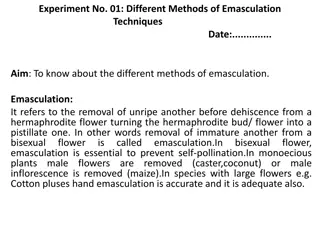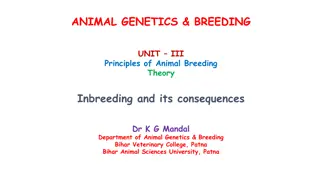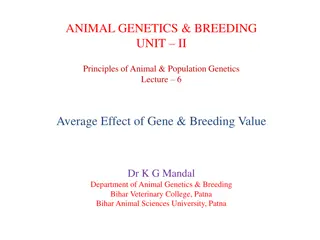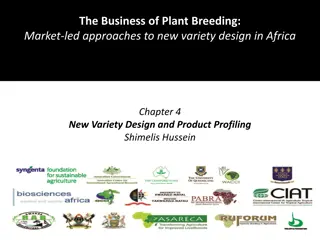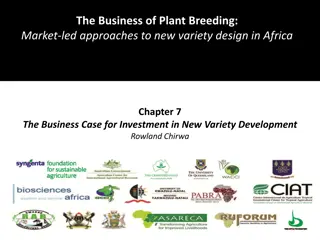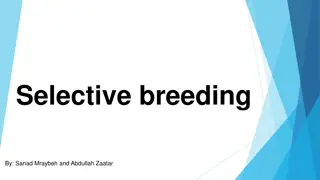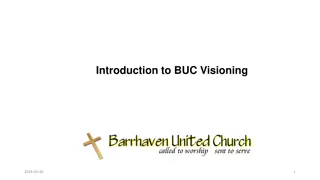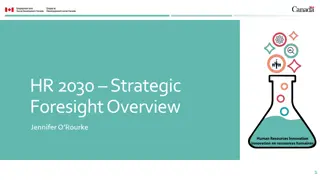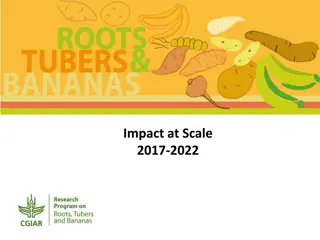Visioning and Foresight for Plant Breeding Goals in Africa
This chapter focuses on empowering plant breeders in Africa to consider future agricultural landscapes, design new varieties that meet market demands, and identify potential drivers influencing farmers' adoption of new varieties. Through methodologies like STEEP analysis and scenario creation, the manual aims to integrate foresight into new variety design and facilitate risk management for sustainable plant breeding practices in Africa.
Download Presentation

Please find below an Image/Link to download the presentation.
The content on the website is provided AS IS for your information and personal use only. It may not be sold, licensed, or shared on other websites without obtaining consent from the author.If you encounter any issues during the download, it is possible that the publisher has removed the file from their server.
You are allowed to download the files provided on this website for personal or commercial use, subject to the condition that they are used lawfully. All files are the property of their respective owners.
The content on the website is provided AS IS for your information and personal use only. It may not be sold, licensed, or shared on other websites without obtaining consent from the author.
E N D
Presentation Transcript
Demand-Led Plant Breeding Training Manual The Business of Plant Breeding: Market-led approaches to new variety design in Africa Chapter 2 Visioning and Foresight for Setting Breeding Goals Nasser Yao, Appolinaire Djikeng and Jonathan Shoham
Chapter 2 Visioning and Foresight for Setting Breeding Goals Nasser Yao*, Appolinaire Djikeng* and Jonathan Shoham** *Biosciences for Eastern and Central Africa (BecA) - International Livestock Research Institute ** Syngenta Foundation for Sustainable Agriculture, WRO-1002.11.54, P.O. Box 4002, Basel, Switzerland.
Chapter 2 Objectives 1. To empower plant breeders and R&D leaders to consider future agricultural landscapes in Africa. 2. To equip breeders with methodologies to design new varieties that will remain relevant and satisfy market demands over time. 3. To identify drivers that may affect whether farmers adopt new varieties in the future.
Chapter 2 Contents 1. Introduction 2. African Agricultural Outlook, Challenges and Policy 3. Visioning and Foresight, using STEEP Analysis and Scenario Creation 4. Integrating Foresight into New Variety Design 5. Risk Management
1. Introduction Group Discussion What is your time frame to create and release a new variety? How do you forecast the future demand of your varieties?
2. African Agricultural Outlook, Challenges and Policy
Africa at a Glance: Agricultural landscape Food supply vs. demand Demand growth is fastest in the world SSA population c. 800 million 220 million undernourished Demand Mean population growth in SSA is c. 3% (-ve Europe, 0.5% Rest of the World) Population size expected to double in 35 years Population growth is double in urban vs. rural areas
Africa at a Glance: Highest Rate of Population Growth 3.5% Population growth: CAGR 2010-2050 3.0% 2.5% 2.0% 1.5% Urban 1.0% Rural Total 0.5% 0.0% AFRICA ASIA EUROPE LATIN AMERICA AND THE CARIBBEAN NORTHERN AMERICA -0.5% -1.0% 1.0 4.2 0.7 0.6 0.3 -1.5% Total population billion (2010) Source: UNFPA
Africa at a Glance: High GDP per Capita Growth: 2004 13 14000 4% Growth 2004-2013 12000 5% GDP per capita: $ 10000 9% 8000 3% 4%5% 6000 7% 4%5%5%3%6%3%4%5%8%3%6%1%2%3%5%7%6% 2% 3%10%2% 2% 0% 6% 4000 2000 0 Nigeria Zambia Lesotho Kenya Swaziland Sudan Senegal Sierra Leone Benin Ethiopia Namibia Ghana Cameroon Guinea South Africa Zimbabwe Togo Eritrea Mozambique Angola Congo, Rep. Tanzania Guinea-Bissau Chad Rwanda Uganda Mauritania Gambia, The Mali Burkina Faso Madagascar Source: World Development Indicators (World Bank); SFSA analysis
Challenges of SSA Agriculture: Low Productivity in Smallholder Farming Low Crop Yields Food insecurity not enough to eat not No capital to invest for high quality inputs enough to invest Vicious Cycle of Poverty Low/no marketable surplus not enough to sell Low/no farm cash income Poverty & unemployment Tonne/ha (2014) 12 10 8 6 4 2 0 Corn Cotton Millet Rice Sorghum Wheat Source: PSD (USDA) East Asia European Union - 28 North America South America Sub-Saharan Africa
Reasons for the Low Productivity Input market constraints Seed laws/industry Local fertilizer industry Distribution system Credit availability Poor access to markets (lack of access to resources/inputs) WEAK PRIVATE SECTOR Rapid urbanization growth (lack of access to land, degradation of natural resources) Low investment in agricultural research, training and extension services Agricultural constraints Infrastructure; land rights African crop diversity/uniqueness Lack of extension/various farming systems Lack of storage Overall constraints War; corruption; governance; education; lack of country economies of scale Low inter-regional trade Highest Tariffs Source: J L Shoham
However we are now in a period of renewing optimism . ..And it is possible for Africa to feed itself and generate income.. - Uganda: Growing apples, displacing imports - Zambia: Increase of cotton production - Kenya: Flower exports surpassed coffee exports - Ethiopia: Beans and coffee from local cooperatives responding well to international markets - DRC: Post-conflict areas relying on cavies for nutrition and growth
Optimism in African Agriculture Exists.. GDP growth forecasts for 2015: Africa and Asia leading 4.5 through significant agricultural transformation Source: The World in 2015 , The Economist
Strategies for Transforming African Agriculture Improving agricultural productivity Availability and widespread use of quality farm inputs and technologies, including crop biotechnologies Facilitating growth in agricultural markets and trade Investing in public infrastructure for agricultural growth Reducing rural vulnerability and insecurity Improving agricultural policy and institutions Foresight and visioning to meet market/consumers demands
Global Seed Companies in Africa DuPont Pioneer Monsanto Vilmorin Seed Co Syngenta Others Southern South Africa Zambia Zimbabwe Malawi Others Lesotho, Botswana, Angola Angola, Botswana, Swaziland Angola/Baddar Eastern Kenya Tanzania Uganda Ethiopia Mozambique Others North Morocco Tunisia Egypt Algeria Libya West Nigeria Ghana Senegal Others Setting up Rwanda Baddar Baddar Setting up Baddar Baddar Baddar: Benin /BF /Cameroon/Chad/Cote D Ivoire/ Guinea/Mali Burkina Faso DRC # Countries 15 <10 NA 15 NA Baddar: 15 Bayer: 8 Source: Commercial Seed Market in Africa, J L Shoham, Informa, 2014
African seed companies and crops portfolio Source: Commercial Seed Market in Africa, J L Shoham, Informa, 2014
3. Visioning and foresight using STEEP analysis and scenario creation
3. Visioning and foresight using STEEP analysis and scenario creation How accurately can we predict the future? Too many factors and interactions to consider? Focus on key drivers of change Construct a range of possible future scenarios What actually happens is more likely a hybrid Test strategies for robustness against these scenarios
STEEP: Useful Framework for Identifying Drivers of Change Identify the drivers of change by type Social Technological Economic Environmental Political/Policy
STEEP Analysis and Scenario Creation STEP 1 Identify key drivers of change and assess their predictability STEP 2 Access reliable information sources STEP 3 Scenario creation using unpredictable drivers ( splitting factors ) STEP 4 Variety specification validation
Social Drivers Driver Impact Predictability Source Population growth Total demand High UN data Urbanization Dietary habits and tastes High UN data GM accept- ability and regulation Technical possibilities Low IFPRI, ISAAA, News media
Technological drivers Driver Impact Predict Biotechnology Genetic variance, speed and cost Low High throughput phenotyping Selection intensity, number of years per breeding cycle Low High throughput genotyping Selection accuracy, breeding speed and cost High Pre-Breeding Breeding possibilities Low Core Breeding Breeding possibilities Low Post Breeding Breeding possibilities Low Big Informatics data Data management and analysis Low
Economic Drivers Driver Impact Predict. Source GDP/capita Food consumption patterns High World Bank FAO Food Balance Sheets Food industry /retailer development Demand for improved seeds, AMC s, Scope for PPP s Medium Reardon (2011) Seed company developments Dealer network Accessibility of Seed improvement Medium Informa (2014) Low AGRA (2013) seeds
Selected Multi-Country Retailers in Africa Source: Promar, Insight, June 2014
Environmental Drivers Driver Impact Predict. Source/ Milestones Climate change Crop yields Agronomic traits Extreme events Traceability Food safety Export market access Crops yields and quality Low IPCC/Paris 2015 Certification schemes Medium Pest incidence Low CABI Plantwise
Political Drivers Driver Impact Predictability Source National seed laws IP protection Private sector investments Low SeedQuest Regional seed/variety harmonization schemes Development costs, speed of variety release Low COMESA, ECA, ECOWAS SADC Ag policies (CAADP) Investment focus Low CAADP web site Nutrition policies Consumer traits Medium IFPRI
Seed Harmonization Schemes Regional grouping Status SADC (Southern Africa) MoU signed 2013 It is now for individual countries to join up COMESA (Eastern and Southern Africa) Draft COMESA Seed Trade Harmonization regulations adopted Sept 2013 EAC (East Africa) 2-year project started Oct 2013 ECOWAS (West Africa) Seed Regulation adopted in 2008 but not yet implemented in most countries Source: Commercial Seed Market in Africa, J L Shoham, Informa, 2014
Group Exercise What is your time frame to create and release a new variety ? Identify drivers of change that could affect your variety designs on this time frame Which drivers are unpredictable? What different agriculture scenarios could there be? How could the various scenarios affect the need for plant breeding and new variety designs?
Integrating foresight into new variety design Foresight methods are used to review existing variety designs or as a starting point to create new designs. Every trait characteristic in each product profile should be analysed and a decision taken if the trait and benchmark is likely to remain relevant over the time required for variety development.
Risk management Risk analysis and mitigation is essential for testing long-term viability of demand-led designs Decision points are required in the stage plan and risk spreading considered e.g. benefits and costs of maintaining many biologically diverse germplasm lines
What Next? Having analysed the drivers and identified the splitting factors : Construct 2 4 scenarios around splitting factors Test your breeding strategies against these scenarios Identify signposts and put in place indicators Review and amend variety designs and plant breeding targets
Demand-Led Plant Breeding Training Manual The Business of Plant Breeding: Market-led approaches to new variety design in Africa Chapter 2 Visioning and Foresight for Setting Breeding Goals Nasser Yao, Appolinaire Djikeng and Jonathan Shoham
